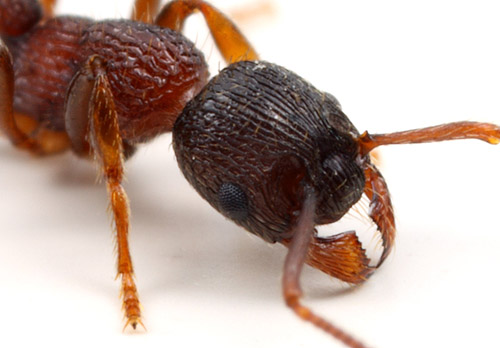...to the quiz.
1. Myrmica fracticornis undescribed species
2. Tetramorium "sp. E." (formerly, T. caespitum)
3. Lasius neoniger
4. Tapinoma sessile
5. Myrmecina americana
6. Pheidole pilifera
Most of these were straightforward, but the Myrmica and the Lasius required as much luck as skill to pick correctly given what was visible in the photographs. The Lasius is indeed covered with the fine hairs that distinguish L. neoniger from L. alienus, but these are nearly impossible to see against the white backdrop.
Identifying Myrmica to species requires examining the shape of the base of the antennae at high magnification, which was not possible in the small photo posted.  I am impressed that some of you picked it anyway. Here's the view that nails it:
 Should I do more of these? What do you think?
Should I do more of these? What do you think?

Well actually, the picture nails it as one of Francoeur's new species, a common one of open (often drier) woods, shrubland and grassland areas, and also parks and old lawns, in eastern US and SE Canada -- one I'll abbreviate as Myrmica "sculp", to avoid using the still unpublished name. By contrast, in the southern patrt of its range, which includes central Illinois, fracticornis is ecologically conservative, found only in fens and remnant wet prairie sites.
Compare the antenal base of your specimen with that of this specimen http://content2.eol.org/content/2009/01/13/15/22010_large.jpg and you will observe quite a different configuration. In fracticornis, the process at the bend is essentially a rounded ridge with a distal hump, that parallels the length of the scape near its anterior edge. In "sculp" the process is a transverse, cup- or ladel-like structure, with a ridge extending down to the base near its posterior edge. Hard to describe, but very different once you get the knack of it.
Also note the thoracic rugae. In fracticornis the rugae vary in width and height, are narrow and relatively sharp dorsally, and are partially anastomosing as in http://www.antweb.org/bigPicture.jsp?code=CASENT0104832&name=Myrmica fracticornis&picture=/images/casent0104832/casent0104832_d_1_high.jpg. In "sculp" the rugae are roughly all of the same width, broader, dorsally flattened, straighter and more parallel, and not anastomosing behind the anteriormost part of the pronotum.
We eagerly await Andre's revision of this group that will shed much light on diversity of this abundant genus.
Another point I forgot to mention, "sculp" is quite typically misidentified in collections as either fracticornis or emeryana, both of which are in fact less common, but have published names that people like to use.
Crud. Failing my own quiz!
Thanks for the commentary, James. The thought had occurred to me that I could be dealing with one of Francoeur's mystery Myrmica, but then I restricted the options to just the named species on Antweb- pretty much as you describe for folks who publish under the names fracticornis and emeryana.
As a rank outsider who's only answer to any quiz here would be 'An ant?', go for it. That last one was six gorgeous ant photos in one post. What's not to love.